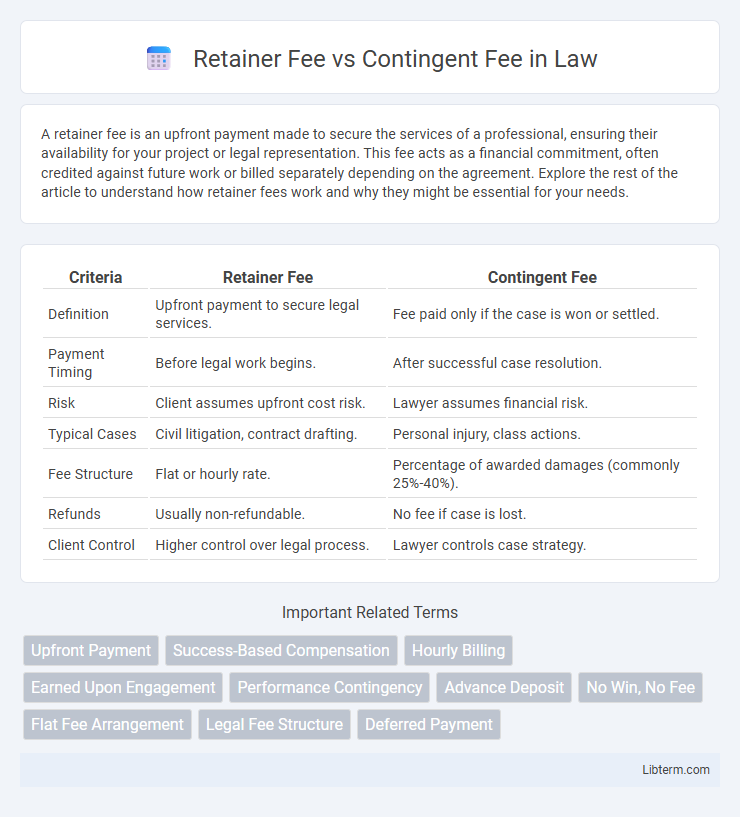A retainer fee is an upfront payment made to secure the services of a professional, ensuring their availability for your project or legal representation. This fee acts as a financial commitment, often credited against future work or billed separately depending on the agreement. Explore the rest of the article to understand how retainer fees work and why they might be essential for your needs.
Table of Comparison
| Criteria | Retainer Fee | Contingent Fee |
|---|---|---|
| Definition | Upfront payment to secure legal services. | Fee paid only if the case is won or settled. |
| Payment Timing | Before legal work begins. | After successful case resolution. |
| Risk | Client assumes upfront cost risk. | Lawyer assumes financial risk. |
| Typical Cases | Civil litigation, contract drafting. | Personal injury, class actions. |
| Fee Structure | Flat or hourly rate. | Percentage of awarded damages (commonly 25%-40%). |
| Refunds | Usually non-refundable. | No fee if case is lost. |
| Client Control | Higher control over legal process. | Lawyer controls case strategy. |
Understanding Legal Fee Structures
Retainer fees require clients to pay an upfront amount to secure legal services, ensuring the attorney's availability and covering initial costs, while contingent fees depend entirely on the case outcome, with the lawyer receiving a percentage of the awarded settlement or judgment. Retainer fees provide predictable expenses, often used in ongoing legal matters, whereas contingent fees shift financial risk to the attorney, commonly applied in personal injury or class action cases. Understanding these fee structures aids clients in selecting appropriate legal representation based on case type, financial capacity, and risk tolerance.
What is a Retainer Fee?
A retainer fee is an upfront payment made to secure the services of a lawyer or professional, ensuring their availability for ongoing legal or consulting work. This fee acts as a deposit against which hourly charges or specific services are billed, providing clients with prioritized access and continuous support. Retainer agreements specify the scope of work and payment terms, offering predictability in legal expenses and fostering a long-term professional relationship.
How Retainer Fees Work
Retainer fees function as upfront payments made to secure legal services, ensuring the attorney's availability and commitment throughout the case. This fee acts as a deposit against which hourly work or specific tasks are billed, providing clients with transparent cost expectations and control over ongoing legal expenses. Unlike contingent fees, retainer fees do not depend on case outcomes, making them a reliable method for funding consistent legal representation.
What is a Contingent Fee?
A contingent fee is a payment arrangement where a lawyer only receives a fee if the case is won or settled favorably, typically calculated as a percentage of the amount recovered. This fee structure aligns the attorney's interests with the client's success, commonly used in personal injury, workers' compensation, and class action lawsuits. Unlike retainer fees, contingent fees do not require upfront payment, reducing financial risk for clients.
How Contingent Fees Operate
Contingent fees operate by requiring no upfront payment and instead charge a percentage of the settlement or judgment awarded to the client. This fee structure aligns the lawyer's interests with the client's success, as payment is contingent upon winning the case. Typically ranging from 25% to 40%, contingent fees incentivize attorneys to maximize compensation while providing access to legal representation without initial costs.
Key Differences: Retainer Fee vs Contingent Fee
Retainer fees require clients to pay upfront for legal services, ensuring attorney availability and covering initial work, while contingent fees are paid only if the lawyer wins the case, usually as a percentage of the settlement or award. Retainer fees provide predictable costs and immediate access to legal support, whereas contingent fees minimize upfront expenses but involve sharing a portion of the financial recovery. The choice between retainer and contingent fees depends on case type, financial capacity, and risk tolerance.
Advantages of Retainer Fees
Retainer fees offer predictable cash flow and secure continuous access to legal expertise, enabling clients to budget effectively and prioritize their cases without unexpected costs. These fees foster a stronger attorney-client relationship by ensuring dedicated availability and consistent legal support throughout the engagement. Unlike contingent fees, retainer fees are charged regardless of case outcome, providing stability and upfront commitment from legal professionals.
Advantages of Contingent Fees
Contingent fees offer the advantage of risk-free legal representation since clients only pay if the case is won or settled, making legal services accessible without upfront costs. This fee structure aligns the attorney's interests with the client's outcome, fostering motivation for maximum compensation. Contingent fees are particularly beneficial in personal injury and employment law cases where financial barriers might otherwise deter clients from seeking justice.
Which Fee Structure is Right for You?
Choosing between a retainer fee and a contingent fee depends on your financial situation and risk tolerance. Retainer fees require upfront payment, offering consistent legal representation and immediate access to services, ideal for clients with steady resources. Contingent fees, common in personal injury cases, are paid only if you win, minimizing upfront costs but possibly resulting in higher overall expenses if successful.
Important Considerations Before Choosing a Legal Fee Arrangement
Retainer fees require upfront payment to secure legal services, offering predictability and ongoing access to counsel, while contingent fees depend on case outcomes, typically involving a percentage of the settlement or judgment. Important considerations before choosing include the nature and complexity of the legal matter, financial capacity to pay initial fees, and risk tolerance for payment based on successful results. Clients must also evaluate the potential total cost, the lawyer's experience with each fee structure, and how each arrangement aligns with their case goals and budget constraints.
Retainer Fee Infographic

 libterm.com
libterm.com